

**The Evolution of Text Conversion: From Manual Processes to Automated Tools** Explore the history of text conversion, highlighting how technology has transformed the way we convert letters and characters. Discuss the impact of automation on efficiency and accuracy in various fields.
The evolution of text conversion has undergone significant changes from manual processes to sophisticated automated tools, fundamentally transforming how we handle letters and characters. This journey can be divided into several key phases, each marked by technological advancements that have improved efficiency and accuracy across various fields.
1. Manual Text Conversion
In the early days of written communication, text conversion was a manual process. Scribes painstakingly copied texts by hand, often using quills and ink on parchment. This labor-intensive method was not only time-consuming but also prone to human error. For instance, the copying of religious texts by monks during the Middle Ages often led to variations and inaccuracies, as each scribe interpreted the text differently.
2. Typewriters and Early Mechanical Devices
The invention of the typewriter in the 19th century marked a pivotal point in text conversion. Machines like the Sholes and Glidden typewriter (the first commercially successful typewriter) allowed for faster and more uniform text production. However, text conversion still required significant manual input, and the process of converting handwritten notes to typewritten documents was still labor-intensive.
3. The Advent of Digital Technology
The introduction of computers in the latter half of the 20th century revolutionized text conversion. Optical Character Recognition (OCR) technology emerged in the 1960s, enabling machines to read and convert printed or handwritten text into digital formats. For example, systems like the Xerox 9700 used OCR to convert scanned documents into editable text, which significantly reduced the time needed for data entry.
4. Automation and Advanced OCR
As technology progressed, the development of advanced OCR software, such as ABBYY FineReader and Adobe Acrobat, further improved the accuracy of text conversion. These tools leverage machine learning algorithms to recognize characters and words with high precision, even in complex layouts and fonts. Businesses began adopting these automated solutions to digitize documents, leading to enhanced efficiency. For example, banks utilized OCR for check processing, allowing them to handle thousands of transactions daily with minimal human intervention.
5. Natural Language Processing (NLP) and AI
With the rise of artificial intelligence and natural language processing in the 21st century, text conversion has reached new heights. AI-powered tools can now not only convert text but also understand context, sentiment, and meaning. Applications like Google Translate utilize NLP to convert text across languages, enabling real-time communication globally. This automation has drastically improved accuracy in translation and accessibility, benefiting fields such as international business, education, and tourism.
Impact of Automation on Efficiency and Accuracy
The impact of automation on text conversion has been profound:
- Efficiency: Automated tools can process large volumes of text far more quickly than manual methods. For instance, a business that previously took hours to transcribe meeting notes can now achieve the same result in minutes using speech-to-text software.
- Accuracy: Automation reduces human error significantly. OCR and AI-based systems can achieve accuracy rates above 98%, making them reliable for critical applications such as legal document management and medical records.
- Cost-Effectiveness: By reducing labor costs and increasing output, organizations can allocate resources more effectively. For example, a law firm using automated document generation tools can save on clerical staff while increasing their capacity to handle cases.
Conclusion
The evolution of text conversion from manual processes to automated tools illustrates a remarkable journey driven by technological advancements. As we continue to innovate, the future of text conversion holds the promise of even greater efficiency and accuracy, paving the way for new applications and enhancements in numerous fields. The transformation from labor-intensive manual methods to cutting-edge automated solutions exemplifies how technology can fundamentally change our approach to communication and information processing.
References:
- Gulrajani, I., & Belinkov, Y. (2020). Towards a Better Understanding of Text-to-Text Transfer Learning. arXiv:2006.07243.
- Wang, T., & Sinha, A. (2018). A Survey of Optical Character Recognition. Expert Systems with Applications, 92, 1-18.
Related Posts
© 2025 Invastor. All Rights Reserved

User Comments